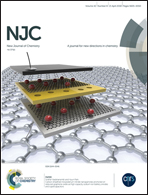Covalent immobilization of doxorubicin in glycine functionalized hydroxyapatite nanoparticles for pH-responsive release†
Abstract
In this study, amino acid (glycine) functionalized hydroxyapatite nanoparticles (Gly-HANPs) were synthesized in situ by a simple co-precipitation method. The structural and morphological properties of the synthesized nanoparticles were evaluated using various characterization techniques including powder X-ray diffraction and electron microscopy. The presence of glycine functionalities on the surface of the nanoparticles was ascertained from infrared spectroscopy, thermal analysis, CHN analysis and zeta potential measurements. Doxorubicin (DOX), an anthracycline antibiotic commonly used in cancer chemotherapy, was covalently bound to Gly-HANPs via a pH sensitive imine linkage using glutaraldehyde as a cross-linker. The DOX loaded nanoparticles (DOX-Glut-Gly-HANPs) showed pH-responsive controlled and sustained release of the drug. In particular, the drug release rate from nanoparticles was higher under acidic pH conditions, characteristic of tumour tissues, than at physiological pH, typical for normal tissues. The higher release of DOX at acidic pH is indicative of the cleavage of the imine (–C![[double bond, length as m-dash]](https://www.rsc.org/images/entities/char_e001.gif) N–) linkage at acidic pH. The cell uptake and therapeutic efficacy of DOX conjugated nanoparticles were investigated in WEHI-164 mouse fibrosarcoma cancer cells. The in vitro cytotoxicity studies suggested that glutaraldehyde treated nanoparticles (Glut-Gly-HANPs) have insignificant cytotoxicity towards WEHI-164 cancer cells, however the DOX loaded nanoparticles exhibited significant dose and time dependent cytotoxicity towards WEHI-164 cells. Furthermore, the confocal laser scanning microscopy studies demonstrated good cellular uptake of the DOX loaded nanoparticles into the WEHI-164 cells. The obtained results suggested that these nanoparticles can serve as potential carriers for the pH-triggered delivery of an anticancer drug.
N–) linkage at acidic pH. The cell uptake and therapeutic efficacy of DOX conjugated nanoparticles were investigated in WEHI-164 mouse fibrosarcoma cancer cells. The in vitro cytotoxicity studies suggested that glutaraldehyde treated nanoparticles (Glut-Gly-HANPs) have insignificant cytotoxicity towards WEHI-164 cancer cells, however the DOX loaded nanoparticles exhibited significant dose and time dependent cytotoxicity towards WEHI-164 cells. Furthermore, the confocal laser scanning microscopy studies demonstrated good cellular uptake of the DOX loaded nanoparticles into the WEHI-164 cells. The obtained results suggested that these nanoparticles can serve as potential carriers for the pH-triggered delivery of an anticancer drug.



 Please wait while we load your content...
Please wait while we load your content...